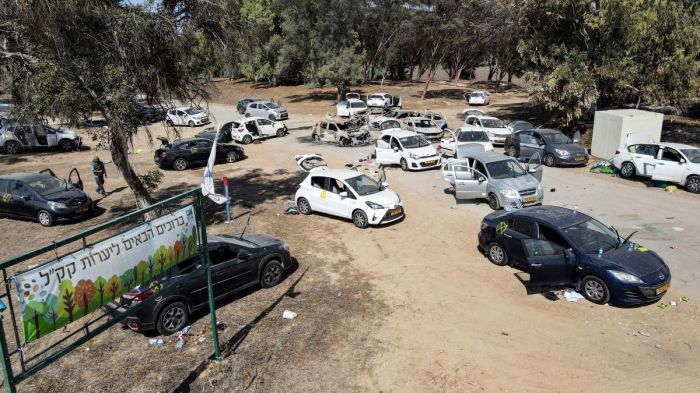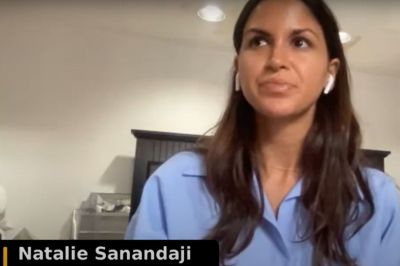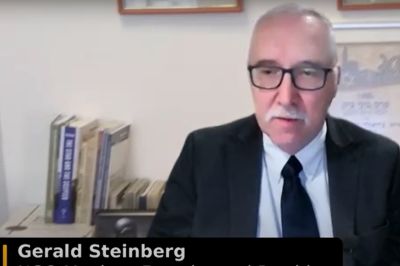'This is not the time': Survivor of Hamas music festival massacre scolds anti-Israel protestors

A survivor of the massacre committed by the Hamas terrorist group at the Nova music festival admonished anti-Israel protestors during a webinar this week addressing media coverage of the ongoing Israel and Hamas war and how it often undermines the Jewish state's right to self-defense.
The Combat Antisemitism Movement hosted the online event Wednesday after Hamas terrorists launched an Oct. 7 offensive targeting civilians in southern Israeli communities near the border with Gaza, killing over 1,400 people and taking at least 199 individuals hostage. CAM CEO Sacha Roytman Dratwa served as the event's moderator.
Participants in the webinar included CAM Advisory Board Chair Natan Sharansky, IDF Maj. (Res.) Ben Wahlhaus and NGO Monitor Founder and President Gerald Steinberg. Also speaking at the event were Natalie Sanandaji, a survivor of the Nova music festival; and Yoav Shimon, the grandson of Bracha Levinson, a woman murdered by Hamas at Israel's Nir Oz kibbutz.

Sanandaji recalled attending the festival in Re'im on Oct. 7 with a group of people, of which she was the only American.
The festival, which was supposed to be an all-night dance party, was disrupted by rocket fire.
One of the girls in Sanandaji's group assured her that things like this were normal and that the music festival would resume once the rocket fire stopped.
"If anyone can imagine anywhere else in the world that kids were at a music festival, and suddenly rockets are being intercepted over their head, no other children would react the way these kids reacted," she said.
"No other children would react in such a calm manner. Any other kids, anywhere else in the world, would have run right away," Sanandaji continued. "But what people need to understand is that for Israeli kids, this is their reality. This is something that they've grown up with."
After security at the festival requested that everyone evacuate, Sanandaji and the rest of her group returned to their cars, still unaware of the severity of the situation. Sanandaji said the group anticipated traffic as they left the festival area but believed they were relatively safe due to the Iron Dome protecting them from rockets.
The group became nervous after being told to drive in a different direction, feeling like something was going on. As they headed another way, Sanandaji remembered that festival security instructed everyone to pull over.
At first, Sanandaji didn't understand, believing that the rockets were the only danger, but when she heard the first gunshot, she understood.
"Terrorists are here on foot, and they're a few feet away, and they have guns, and they're shooting at us," she said. "We opened our doors, and we just started to run for our lives."
In one terrifying moment, Sanandaji said she was running in one direction when she suddenly saw dozens of children run towards her from the opposite direction. She realized that she had not been running to safety, as the kids were running from a terrorist who was shooting at them.
"Nobody knew what direction was safe," she said. "Basically, no direction was safe. They were coming at us from multiple directions."
The group continued running until they came across a ditch where multiple kids were already hiding, and they urged Sanandaji and her friends to hide with them. Sanandaji almost did, but one of her friends vetoed the idea, saying they'd be easy targets if the terrorists found them.
Sanandaji later learned that Hamas terrorists murdered every person who chose to hide in the ditch.
Sanandaji and her group ran for hours until they encountered a police officer armed with only a handgun. Since the terrorists had taken over the local police station, he couldn't call for backup, but the officer did his best to guide the group in the right direction.
After running for hours, the group stopped to catch their breath under a tree until a white van approached. At first, they thought it was a terrorist, but then they realized it was a man from a nearby town who had risked his life to save the festival attendees. Sanandaji never learned the man's name because as soon as he dropped her group off in the nearby town, he drove back to save more people.
The survivor said she doesn't cry for herself but for the other festival attendees who suffered a different fate than her that day.
Sanandaji also addressed the activists who have responded to the attack and Israel's retaliatory airstrikes that Hamas-run authorities say have killed over 3,000 people by holding protests and chanting things like "Free Palestine," arguing that they misunderstand the point of the current war.
"Hamas is not pro-Palestine. Hamas is just as complicit in the deaths of innocent Palestinians as they are in the deaths of all these innocent Israelis," she said. "Anyone who is going out onto the streets with a Palestinian flag, this is not the time."
"This war is about a terrorist organization killing innocent people," the survivor added. "Killing innocent people does not free Palestine. This is not the path to that; this is not the way you do it."

During his remarks, Steinberg criticized some media outlets for attempting to paint Israel as the "worst human rights violator," noting how multiple outlets rushed to blame Israel Tuesday for the explosion of the Al-Ahli Arab Hospital in Gaza.
Israel Defense Forces, however, stated that the blast was caused by an "errant rocket fired by a terrorist group in Gaza," and data gathering by U.S. officials supported the claim that Israel wasn't responsible.
Although Hamas-run health authorities claimed that about 471 people died in the hospital explosion, U.S. intelligence agencies on Thursday claimed in an unclassified assessment that the death toll was likely between 100-300. U.S. officials who spoke with The New York Times on the condition of anonymity said that the death toll is likely on the lower end of the estimate.
"This is not just a tactic; it's a strategy of modern anti-Semitism," Steinberg said. "They manipulate the language and frameworks of human rights which were created in the wake of the Holocaust, and this is a form of Holocaust inversion."





























